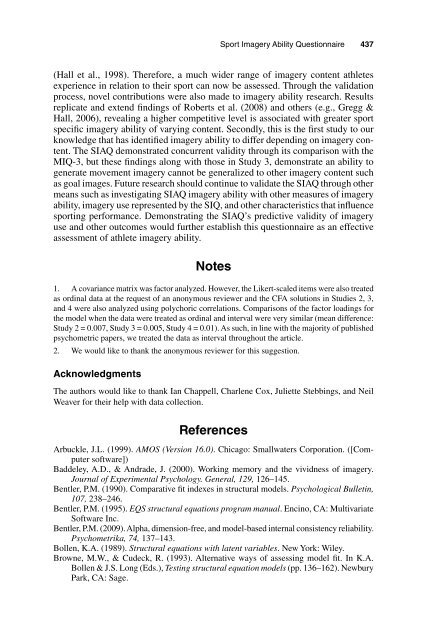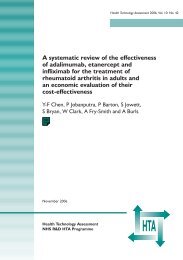<strong>Sport</strong> <strong>Imagery</strong> <strong>Ability</strong> Questionnaire 437 (Hall et al., 1998). <strong>The</strong>refore, a much wider range of imagery content athletes experience in relation to their sport can now be assessed. Through the validation process, novel contributions were also made to imagery ability research. Results replicate and extend findings of Roberts et al. (2008) and others (e.g., Gregg & Hall, 2006), revealing a higher competitive level is associated with greater sport specific imagery ability of varying content. Secondly, this is the first study to our knowledge that has identified imagery ability to differ depending on imagery content. <strong>The</strong> SIAQ demonstrated concurrent validity through its comparison with the MIQ-3, but these findings along with those in Study 3, demonstrate an ability to generate movement imagery cannot be generalized to other imagery content such as goal images. Future research should continue to validate the SIAQ through other means such as investigating SIAQ imagery ability with other measures of imagery ability, imagery use represented by the SIQ, and other characteristics that influence sporting performance. Demonstrating the SIAQ’s predictive validity of imagery use and other outcomes would further establish this questionnaire as an effective assessment of athlete imagery ability. Notes 1. A covariance matrix was factor analyzed. However, the Likert-scaled items were also treated as ordinal data at the request of an anonymous reviewer and the CFA solutions in Studies 2, 3, and 4 were also analyzed using polychoric correlations. Comparisons of the factor loadings for the model when the data were treated as ordinal and interval were very similar (mean difference: Study 2 = 0.007, Study 3 = 0.005, Study 4 = 0.01). As such, in line with the majority of published psychometric papers, we treated the data as interval throughout the article. 2. We would like to thank the anonymous reviewer for this suggestion. Acknowledgments <strong>The</strong> authors would like to thank Ian Chappell, Charlene Cox, Juliette Stebbings, and Neil Weaver for their help with data collection. References Arbuckle, J.L. (1999). AMOS (Version 16.0). Chicago: Smallwaters Corporation. ([Computer software]) Baddeley, A.D., & Andrade, J. (2000). Working memory and the vividness of imagery. Journal of Experimental Psychology. General, 129, 126–145. Bentler, P.M. (1990). Comparative fit indexes in structural models. Psychological Bulletin, 107, 238–246. Bentler, P.M. (1995). EQS structural equations program manual. Encino, CA: Multivariate Software Inc. Bentler, P.M. (2009). Alpha, dimension-free, and model-based internal consistency reliability. Psychometrika, 74, 137–143. Bollen, K.A. (1989). Structural equations with latent variables. New York: Wiley. Browne, M.W., & Cudeck, R. (1993). Alternative ways of assessing model fit. In K.A. Bollen & J.S. Long (Eds.), Testing structural equation models (pp. 136–162). Newbury Park, CA: Sage.
438 Williams and Cumming Byrne, B.M. (2010). Structural equation modeling with AMOS: basic concepts, applications, and programming (2nd ed.). New York: Taylor and Francis. Callow, N., & Hardy, L. (2001). Types of imagery associated with sport confidence in netball players of varying skill levels. Journal of Applied <strong>Sport</strong> Psychology, 13, 1–17. Callow, N., & Waters, A. (2005). <strong>The</strong> effect of kinesthetic imagery on the sport confidence of flat-race horse jockeys. Psychology of <strong>Sport</strong> and Exercise, 6, 443–459. Campos, A., Pérez-Fabello, M.J., & Gómez-Juncal, R. (2004). Gender and age differences in measured and self-perceived imaging capacity. Personality and Individual Differences, 37, 1383–1389. Cheung, G.W., & Rensvold, R.B. (2002). Evaluating goodness-of-fit indexes for testing measurement invariance. Structural Equation Modeling, 9, 233–255. Costello, A.B., & Osborne, J.W. (2005). Best practices in exploratory factor analysis: Four recommendations for getting the most from your analysis. Practical Assessment. Research Evaluation, 10, 1–9. Cudeck, R., & Brown, M.W. (1983). Cross-validation of covariance structures. Multivariate Behavioral Research, 18, 147–167. Cumming, J. (2008). Investigating the relationship between exercise imagery, leisure time exercise behavior, and self-efficacy. Journal of Applied <strong>Sport</strong> Psychology, 20, 184–198. Cumming, J., Clark, S.E., Ste-Marie, D.M., McCullagh, P., & Hall, C. (2005). <strong>The</strong> Functions of Observational Learning Questionnaire. Psychology of <strong>Sport</strong> and Exercise, 6, 517–537. Cumming, J., & Hall, C. (2002). <strong>Athlete</strong>s’ use of imagery in the off-season. <strong>The</strong> <strong>Sport</strong> Psychologist, 16, 160–172. Cumming, J., & Ramsey, R. (2009). <strong>Sport</strong> imagery interventions. In S. Mellalieu & S. Hanton (Eds.), Advances in applied sport psychology: A review (pp. 5–36). London: Routledge. Cumming, J., Olphin, T., & Law, M. (2007). Self-reported psychological states and physiological responses to different types of motivational general imagery. Journal of <strong>Sport</strong> & Exercise Psychology, 29, 629–644. Cumming, J., & Ste-Marie, D.M. (2001). <strong>The</strong> cognitive and motivational effects of imagery training: A matter of perspective. <strong>The</strong> <strong>Sport</strong> Psychologist, 15, 276–287. Glisky, M. L., Williams, J. M., & Kihlstrom, J. F. (1996). Internal and external imagery perspectives and performance on two tasks. Journal of <strong>Sport</strong> Behavior, 19, 3–18. Goss, S., Hall, C., Buckolz, E., & Fishburne, G. (1986). <strong>Imagery</strong> ability and the acquisition and retention of movements. Memory & Cognition, 14, 469–477. Gregg, M., & Hall, C. (2006). Measurement of motivational imagery abilities in sport. Journal of <strong>Sport</strong>s Sciences, 24, 961–971. Hair, J. F., Anderson, R. E., Tatham, R. L., & Black, W. C. (1998). Multivariate data analysis. Upper Saddle River, NJ: Prentice Hall. Hall, C.R. (1998). <strong>Measuring</strong> imagery abilities and imagery use. In J.L. Duda (Ed.), Advances in sport and exercise psychology measurement (pp. 165–172). Morgantown, WV: Fitness Information Technology. Hall, C.R. (2001). <strong>Imagery</strong> in sport and exercise. In R.N. Singer, H.A. Hausenblas, & C.M. Janelle (Eds.), <strong>The</strong> handbook of sport psychology (2nd ed., pp. 529–549). New York: John Wiley & Sons Inc. Hall, C.R., Buckolz, E., & Fishburne, G. (1992). <strong>Imagery</strong> and the acquisition of motor skills. Canadian Journal of <strong>Sport</strong> Sciences, 17, 19–27. Hall, C., Mack, D., Paivio, A., & Hausenblas, H. (1998). <strong>Imagery</strong> use by athletes: Development of the sport imagery questionnaire. International Journal of <strong>Sport</strong> Psychology, 29, 73–89. Hall, C., & Martin, K. A. (1997). <strong>Measuring</strong> movement imagery abilities: A revision of the Movement <strong>Imagery</strong> Questionnaire. Journal of Mental <strong>Imagery</strong>, 21, 143–154. Hu, L., & Bentler, P.M. (1999). Cutoff criteria for fit indices in covariance structure analysis: Conventional criteria versus new alternatives. Structural Equation Modeling, 6, 1–55.
















